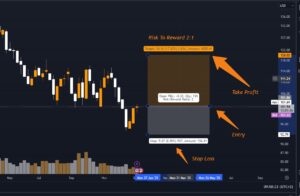Module 2: Position Sizing and Risk-Reward Principles
Introduction: The Foundation of Smart Trading
Position sizing and understanding risk-reward principles are critical skills for every trader. These concepts ensure that your trades are appropriately scaled to your account size and align with your risk tolerance. By mastering these principles, you’ll protect your capital and maximize profitability, even during periods of market volatility.
In this module, you’ll learn:
- How to calculate the right position size for any trade.
- The importance of the risk-reward ratio and how to use it effectively.
- Practical examples of applying these principles to real-world trading scenarios.
What is Position Sizing?
Definition
Position sizing determines how much of your account you allocate to a single trade. It’s the cornerstone of risk management because it directly impacts how much money you stand to gain or lose.
Why It’s Important
- Protects Your Account: Prevents overexposure and excessive losses.
- Enables Consistency: Ensures you can survive a series of losing trades.
- Aligns Risk with Goals: Helps you balance risk and potential reward effectively.
How to Calculate Position Size
The position size you take on a trade depends on:
- Account Balance: Your total capital available for trading.
- Risk Percentage: The percentage of your account you’re willing to risk per trade (commonly 1-2%).
- Stop-Loss Size: The number of pips between your entry price and stop-loss level.
- Pip Value: The monetary value of each pip for the currency pair you’re trading.
Formula
Position Size = (Account Balance × Risk %) ÷ (Stop Loss in Pips × Pip Value)
Example
- Account Balance: $10,000
- Risk: 1% ($100 per trade)
- Stop-Loss: 20 pips
- Pip Value: $10 (for a standard lot)
Position Size = ($10,000 × 0.01) ÷ (20 × $10) = 0.5 lots
In this case, you would trade 0.5 lots (50,000 units) to ensure your risk remains within 1%.
What is the Risk-Reward Ratio?
Definition
The risk-reward ratio compares the potential loss (risk) to the potential gain (reward) on a trade. It’s a key metric for planning profitable trades.
Why It’s Important
- Ensures Profitability: A positive risk-reward ratio (e.g., 1:2) means you only need to win a smaller percentage of trades to be profitable.
- Encourages Discipline: Helps traders set realistic take-profit and stop-loss levels.
How to Use the Risk-Reward Ratio
Setting Up a Trade
- Define your stop-loss level (e.g., 20 pips below entry).
- Set a take-profit target that’s at least 2x your stop-loss (e.g., 40 pips above entry).
- Calculate your ratio: Risk (20 pips) vs. Reward (40 pips) = 1:2.
Example
- Entry Price: 1.1000
- Stop-Loss: 1.0980 (20 pips below entry)
- Take-Profit: 1.1040 (40 pips above entry)
This trade has a 1:2 risk-reward ratio. Even if you only win 50% of your trades, this ratio ensures long-term profitability.

Winning Percentage Needed
The higher your risk-reward ratio, the fewer trades you need to win to break even.
- 1:1 ratio: Break-even at 50% win rate.
- 1:2 ratio: Break-even at 33% win rate.
- 1:3 ratio: Break-even at 25% win rate.
Common Position Sizing Mistakes
- Overleveraging: Taking positions that are too large for your account size, increasing potential losses.
- Neglecting Stop-Loss Levels: Not factoring in stop-loss sizes when calculating position size.
- Ignoring Volatility: Using the same position size across trades without adjusting for market conditions.
Practical Examples of Position Sizing and Risk-Reward
Scenario 1: EUR/USD Trade
- Account Balance: $5,000
- Risk: 1% ($50)
- Stop-Loss: 30 pips
- Pip Value: $1 per pip
Position Size = ($5,000 × 0.01) ÷ (30 × $1) = 1.67 micro lots (1,670 units)
Scenario 2: Adjusting for Risk-Reward
- Entry Price: 1.2000
- Stop-Loss: 1.1980 (20 pips)
- Take-Profit: 1.2040 (40 pips)
Risk-reward ratio = 1:2. You risk $20 to gain $40, making this a favorable trade.
Key Takeaways
- Position sizing ensures your trades are proportionate to your account size and risk tolerance.
- The risk-reward ratio helps plan trades that align with long-term profitability.
- Always calculate position size and set risk-reward levels before entering a trade.
- Stick to the 1-2% risk rule to protect your account during losing streaks.
Practical Exercise
- Position Size Calculation:
- Use a position size calculator to determine the optimal lot size for a $10,000 account risking 1% with a 25-pip stop-loss.
- Set Risk-Reward Ratios:
- Choose two hypothetical trades and calculate risk-reward ratios for each.
- Simulate Trades:
- Open a demo account and practice applying position sizing and risk-reward principles to at least 5 trades.
What’s Next?
In the next module, Stop-Loss, Take-Profit, and Volatility Management, you’ll learn how to use stop-loss and take-profit orders effectively and incorporate volatility metrics like ATR into your risk strategy.